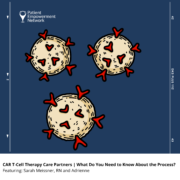Making Myeloma Treatment Decisions at Every Stage of Care
Making Myeloma Treatment Decisions at Every Stage of Care from Patient Empowerment Network on Vimeo.
Dr. Mark Schroeder, of Siteman Cancer Center, reviews the types of treatment approaches available for patients with myeloma, discusses how therapies are chosen and why, including in the relapsed and refractory setting. Dr. Schroeder also shares an update on new and emerging myeloma therapies.
Dr. Mark Schroeder is a hematologist at Siteman Cancer Center of Washington University School of Medicine in St. Louis. Dr. Schroeder serves as Associate Professor in the Department of Medicine. Learn more about Dr. Schroeder, here.
See More from Engaging in Myeloma Treatment Decisions
Related Resources:

|

|

|
Transcript:
Katherine Banwell:
Hello, and welcome. I’m Katherine Banwell, your host for today’s webinar. Today’s program is about how to actively engage in myeloma treatment decisions at every stage of your care. Before we get into the discussion, please remember that this program is not a substitute for seeking medical advice. Please refer to your healthcare team about what might be best for you. Well, let’s meet our guest today. Joining us is Dr. Mark Schroeder. Dr. Schroeder, welcome. Would you please introduce yourself?
Dr. Mark Schroeder:
Yeah. Hi, Katherine. Thanks for having me. I’m Dr. Mark Schroeder. I’m an Associate Professor of Medicine at Washington University School of Medicine in St. Louis.
Katherine Banwell:
Thank you so much for taking the time out of your day to join us. As I mentioned, this webinar is about actively engaging in myeloma care decisions. So, I’d like to start with this important question, why is it essential for patients to play a role in their care and treatment decisions?
Dr. Mark Schroeder:
Yeah, I mean patients are – a patient should be actively involved in decisions with their doctor. As a physician, doctors are thinking about “What is the best treatment for their disease or their cancer?” and patients, I think, have a role in trying to guide the doctor in terms of what outcomes they are seeking from treatment, what is there lifestyle like that we could potentially guide treatment around. Patients have different goals. Sometimes in cancer, we’re going for curative therapies. Sometimes we’re not, and quality of life is more important. Having an actively engaged patient ensures that your doctor is trying to tailor treatment to you.
The patient who is educated also helps to bring resources to their physician about – sometimes physicians may not know of all the clinical trials that are ongoing or potentially even therapies. But have a patient ask about certain studies or ask about certain therapies, it helps to open a conversation with your physician to discuss those and to kind of talk through why it may or may not be a good idea for them in particular.
Katherine Banwell:
Well, thank you. That helps guide us as we begin our conversation. As a patient, engaging in your care starts with understanding your diagnosis, so I’d like to go through some definitions. What is multiple myeloma?
Dr. Mark Schroeder:
Multiple myeloma is a blood cancer. It’s a cancer in particular of a blood cell called a plasma cell. Everybody has normal plasma cells in their body. It’s part of your immune system that responds to infections; they are also cells that respond to vaccinations.
And when a plasma cell becomes a cancer, it often forms a cancer called multiple myeloma. And that cancer results often times in damage to bones, low blood counts or anemia, potentially kidney problems, or possibly seeing high levels of calcium.
Katherine Banwell:
What about smoldering myeloma? What is that?
Dr. Mark Schroeder:
So, smoldering myeloma is a stage that happens prior to the development of myeloma that is causing organ damage. I talked about the damage to bones, kidneys, blood cells – that is called the CRAB criteria. The C stands for calcium, the R renal, A anemia, and B bones. We define myeloma by having damage to one of those four essential systems.
Smoldering myeloma can happen when we actually see plasma cells that look like myeloma – that look like cancer cells, but they’re not causing the CRAB features of multiple myeloma. And there is a chance that sometimes that smoldering form of myeloma, it’s not causing any damage, but it can evolve and change into myeloma.
Katherine Banwell:
What is MGUS?
Dr. Mark Schroeder:
MGUS is a stage that happens prior to smoldering myeloma. We know that MGUS which stands for monoclonal gammopathy of undetermined significance – it’s a mouthful. That’s why we like to say MGUS.
Katherine Banwell:
Yes.
Dr. Mark Schroeder:
But it’s a protein that can be detected in your blood. Sometimes that protein does not mean you have a cancer. We can detect proteins like that in blood in patients who have, say, autoimmune diseases, and they’re at low levels. It’s just an immune response; it’s produced by those plasma cells that can be cancerous, but sometimes plasma cells grow because they’re stimulated – they’re overstimulated.
And so, that monoclonal protein of MGUS can be detected in the blood, but we don’t see an increase in the number of cells in the bones that are classic for myeloma. But we know that about 1 percent of patients who have MGUS, every year, 1 percent might progress on to develop multiply myeloma. So, it’s a risk factor; it’s on the spectrum of disease from MGUS to smoldering myeloma to myeloma.
Katherine Banwell:
Okay. And how is asymptomatic myeloma monitored?
Dr. Mark Schroeder:
So, asymptomatic patients, I would consider those are the patients who have smoldering myeloma, so they don’t have the high calcium, the renal issues, anemia, or bone problems. And typically, those patients are followed up about every three to six months, depending on where they fit in kind of that spectrum of MGUS to smoldering myeloma to myeloma.
Sometimes patients who have clinically identified myeloma and it presents very heterogeneous sometimes. They may not have a lot of organ involvement or organ damage, and maybe they’re frail, they’re elderly. And it may be appropriate also to observe patients who actually have some of the findings of myeloma, but the disease doesn’t seem to be as aggressive.
Katherine Banwell:
Okay. Let’s talk about the different phases of therapy for myeloma, and I’m going to ask you for some more definitions. What is induction therapy?
Dr. Mark Schroeder:
Induction therapy is the first treatment that we’re starting for myeloma. It’s oftentimes a combination of a number of chemotherapies that our goal is to get control of the cancer quickly, so reduce the burden of the cancer in a patient’s body.
Oftentimes, when patients present with myeloma, that’s when the burden of cancer is the highest. So, induction therapy is a combination often of three or four different drugs given over the course of about three to four months to treat the myeloma and get initial control.
Katherine Banwell:
What about consolidation therapy? What is that?
Dr. Mark Schroeder:
So, after you have had a response to induction therapy, your oncologist might talk about, “Well, let’s deepen that response.” That’s when we think about consolidation. So, it’s going to be poten – most of the time is a change of therapy from the three or four drugs that you were treated for in the myeloma. An example of consolidation would be going through a stem cell transplant or more chemotherapy after stem cell transplant. So, that’s a change in therapy, and it ends up deepening the response, killing more of the cancer.
Katherine Banwell:
And what about maintenance therapy?
Dr. Mark Schroeder:
So, after you have gone through induction, you have control of the myeloma, we’ve deepened that response with consolidation, we know that myeloma is a cancer that tends to come back. And we know from experience that continuing some of the drugs that we used in induction at low doses are effective to try and prevent it from progressing or coming back, and it extends that period of time – and that’s maintenance therapy. It’s using some of the drugs we used to initially treat myeloma at lower doses to continue to suppress low levels of the cancer.
Katherine Banwell:
Thank you for that. There are a number of treatments for myeloma patients. Can you talk about the types that are available?
Dr. Mark Schroeder:
Yeah. So, the classes of – actually there is lots of drugs approved for treating myeloma but also recently approved.
And we classify them into big categories. One of the categories is called immunomodulatory drugs – those are drugs like Revlimid and pomalidomide, or even thalidomide which was one of the first immunomodulatory drugs. Those are oral drugs that work on a specific pathway in the myeloma that leads to the myeloma cell dying. Another class of drugs are called proteasome inhibitors. Those include drugs like bortezomib or carfilzomib. Those drugs are often given under the skin or in the vein, and we know that they work really effectively on their own, but also when we combine them with an immunomodulatory drug like Revlimid or pomalidomide, the effect is even better. Another class is steroids. Steroids are kind of one of the first drugs used to treat this cancer, and steroids are effective at treating myeloma cells.
Plasma cells are responsive to steroids. One of the first treatment regimens used to treat myeloma were traditional chemotherapies, and those are usually reserved for later on. You might think of traditional chemotherapy that causes hair loss, nausea, vomiting, low blood counts. Those, decades ago, were used to treat myeloma, but now we have effective oral, IV, or injection into the skin that don’t cause a lot of the traditional chemotherapy side effects but are very effective at treating the myeloma. And then another major class of drugs are considered immunotherapies. So, these are treatments that are engineered to either stimulate the immune system to go attack the myeloma, or maybe it’s even using part of your own immune system to engineer it to go attack the myeloma.
Examples of those are called bispecific antibodies which kind of binds to the myeloma but binds to an immune cell, brings them together, or a CAR-T cell which takes your own T cells genetically modifies them to attack the cancer.
Katherine Banwell:
And there is also a bone marrow transplant. Is that right?
Dr. Mark Schroeder:
That’s right, yeah. I neglected – so, bone marrow transplant has been around for a while in myeloma. And despite it being around for so long and really good therapies being approved for myeloma, it’s still a standard treatment for myeloma. And bone marrow transplant in myeloma uses a traditional chemotherapy called melphalan that is associated with the chemotherapy side effects we talked about. But the advantage of bone marrow transplant is that it prolongs the time before the myeloma comes back and needs other treatments, and that’s why we do it. It can be toxic, but it can prolong the time before a patient needs another line of therapy.
Katherine Banwell:
We know that everyone’s diagnosis is different. So, how do you determine a treatment plan for an individual patient?
Dr. Mark Schroeder:
So, it depends in terms of the patient – initially, I will evaluate patients and determine how fit they are. Is it a patient that I think is strong enough to undergo a stem cell transplant? Is that going to be a benefit to them? That’s not necessarily a factor of just age, but it’s also, are they doing well functionally, or do they have any other medical problems like heart disease or kidney problems? Those things play into my decision on a treatment initially with patients. So, whether you’re fit or unfit will help to guide what your treatment is going to be in general. Fit patients are somebody that could undergo multiple treatments, go through a transplant, have minimal toxicity, and recover fully after more intensive treatments.
Whereas, unfit may need more assistance, and we tend to reduce the intensity of treatments. It doesn’t mean the treatments, if you’re unfit, are less effective – they can be very effective. But our goals for treatment change in that situation. And we’re looking for responses but also looking for quality of life. And then it changes also depending on the genetics of the myeloma. Our treatment for patients who have genetic changes that are high risk will change compared to those that have what are called standard risk genetic changes.
So, that is an important point to discuss with your oncologist if you have – Do I have standard risk or high-risk genetic changes in my cancer? And does that effect my treatment? And then also, treatment in somebody who is being treated a second time or third time or beyond for their myeloma depends on what treatments you had before and how effective they were.
And what were your toxicities or side effects from those treatments? So, all those factors play into a decision of treatment for an individual.
Katherine Banwell:
Oh, that’s great information. Let’s discuss what happens after treatment. How is the effectiveness of a treatment monitored?
Dr. Mark Schroeder:
When you are initially diagnosed with myeloma, we will perform testing of blood. We look for that monoclonal protein or protein in the blood that is produced by the cancer cells. That protein level will be used to monitor the response of the cancer, and that’s a blood test – that’s called a serum protein electrophoresis. Also, initially, we’ll have x-rays of the bones, or it might be a CT scan or an MRI or PET scan that’s used to document if there is any bone damage. And oftentimes when we’re following up, we follow the bloodwork to look for reduction in that protein level.
We may follow up additional x-rays to see if there are new areas in the bones that are damaged or if prior areas have responded to the treatment. And then oftentimes a bone marrow biopsy is used to document if you are in a complete remission which means that the protein we detected before or the cancer cells in the bone marrow cannot be detected after treatment.
Katherine Banwell:
Why is it essential for patients to share any symptoms or issues they may be having with their healthcare team during and after treatment?
Dr. Mark Schroeder:
Yeah, I mean, the treatments for multiple myeloma, they are typically continued in patients, and as we continue these treatments, side effects happen. And as a physician, we can support patients through side effects. It may be as simple as adding a medicine to help with nausea. It may be modifying the dose of the treatments.
So, it’s important to kind of monitor for things like, “I’m having a rash or diarrhea” or “I am getting nausea,” and letting us know right away. What the bad outcome would be if a patient is taking a medicine doesn’t let us know about side effects and decides to stop the medicine. Obviously, if you’re not taking a chemotherapy medicine, it’s not going to be effective to treat your cancer. That happens sometimes. So, having a good communication with your physician and your team of medical providers is important so that we can modify treatment. There are lots of alternatives for adjustments in the treatment that can be made that can be just as effective as the treatment you started on.
Katherine Banwell:
So, communication is key.
Dr. Mark Schroeder:
Yes. For sure, for sure.
Katherine Banwell:
If treatment is successful, then when is a patient considered in remission? And what does remission mean?
Dr. Mark Schroeder:
Remission – there are gradients on remission in myeloma. And we can have a partial remission which means we kill about half of the cancer cells. We can have very good partial remissions, or we can have complete remissions. And those equate to the depth of response or how well the myeloma responded. Those are measured by bloodwork, bone marrow biopsy, and may be repeat imaging or x-rays. So, if you have a complete remission, that means, we can’t detect that protein in the blood that was detected before, or protein that was detected in the urine, and we can’t detect the cancer cells on a bone marrow biopsy. We know that the deeper your remission or response to treatment, that equates typically with a longer time before the cancer may come back or need other therapies.
Myeloma is a type of cancer that tends to come back, so we have very effective therapies, and sometimes, these therapies can get the myeloma to a state that we can’t detect one in a million cancer cells, but it tends to come back. And so, complete remissions means that, “Yes, it’s a good chance that the myeloma is not going to come back for years for you, but you still need to be monitored. You’re not necessarily cured of the cancer.”
Katherine Banwell:
Unfortunately, relapse can occur after treatment as you’ve been talking about. And sometimes, a patient’s disease doesn’t respond to therapy, and that’s called refractory disease. What are the indicators that a patient’s disease may have relapsed?
Dr. Mark Schroeder:
Yeah, so we would typically be following a patient about every three months. Somebody that has gone through the initial induction, consolidation, maybe they’re on maintenance therapy, or maybe they’re on active therapy for after they have relapsed from a myeloma. Each of those visits every three months, we are monitoring bloodwork, we’re monitoring the monoclonal protein that the myeloma produces.
Or if it doesn’t produce much of that protein, we’re monitoring other parameters, so urine testing or maybe even imaging like a PET scan. And we’re looking for consistent rises in that number, and we’re looking for, not necessarily a little rise in the protein, but incremental continuous rise – that suggests that the myeloma is starting to grow again, and it’s growing on the current treatment, and we need to switch gears and try a different treatment. There are some patients who – that protein, the myeloma or the myeloma cancer doesn’t die to treatments – that’s refractory. So, we try a treatment, and there’s just no response. We don’t see a drop in the protein in the blood, we still see a good burden of the myeloma in the bone marrow biopsy. And those patients, that’s also an indication to try a different treatment.
Katherine Banwell:
You mentioned that myeloma often returns, so how typical is it for a patient to relapse?
Dr. Mark Schroeder:
Yeah, I would say that’s the norm for patients with myeloma. There are reports in patients who undergo things like stem cell transplant, that maybe 10 percent of patients might be out 10 years without detection of their myeloma, but that’s not the norm. So, most patients who are diagnosed with myeloma will go through periods of treatment and hopefully periods of remission – the majority go into periods of remission to myeloma where it’s not very active, but the myeloma tends to come back.
Katherine Banwell:
If a person is relapsed or refractory, how are they typically treated?
Dr. Mark Schroeder:
So, when they relapse, it depends on their prior treatment. So, if the myeloma is not responding to a drug, then it is, from the physician’s perspective that’s treating you, a good idea to change the type of chemotherapy drug that you’re on. Any time, whether it’s diagnosis or relapse, clinical trials are appropriate to engage with and potentially even use as primary treatment. All clinical studies in myeloma or for cancer in general are typically engineered around active treatments for the cancer. And so, those studies in myeloma when you’re having the cancer relapse, say, early in the course of your cancer, those studies typically are geared to use drugs that are approved by the FDA. Later in the lines of treatment, maybe you’ve had to progress after four lines of treatment, but trying to move them earlier, and they’re very active in the fourth line.
So, you could potentially have access to an active treatment moved earlier in the treatment through a clinical trial. There is also a long list of other approved myeloma therapies. There is a good handout, I think, through the NCCN for patients for myeloma that lists a lot of the approved myeloma therapies and kind of guides patients. It’s a good resource book that I would point any of the listeners to.
Katherine Banwell:
Oh, that’s a great idea. Thank you for that. What about emerging therapies for myeloma? What approaches are showing promise?
Dr. Mark Schroeder:
So, I think the biggest news in myeloma, and across a lot of cancers now, are immunotherapies. We know in myeloma – now we have two CAR-T cells –
Now a CAR-T cell is engineering your own immune cell called a T cell to express a receptor on its surface that binds to the myeloma, and then those immune cells go and kill the myeloma. That’s a form of immunotherapy.
There’s two CAR-T cells for treating myeloma after the myeloma has come back four times, has needed four treatments. Those are very active in that line of therapy, and we can see response rates over 80 percent in patients who otherwise weren’t responding to other approved therapies for myeloma.
On the other hand, there are other immunotherapies that are used earlier in the treatment course of myeloma. One that is not incorporated more frequently for the initial treatment is a drug called daratumumab – it’s an antibody. It’s a protein that binds to the surface of myeloma and stimulates the immune system to react against the myeloma. And so, it’s not a traditional chemotherapy, but it’s using your own immune system to attack the cancer.
And then a third one that’s probably just as – it looks just as potentially effective as CAR-T cells are called bispecific antibodies. And that would use a protein similar to daratumumab which is an antibody, but it uses parts of antibodies to bind to – it could be two different proteins – one expressed on a T cell, the other one expressed on the myeloma cells. And when it binds, it brings those two cells together and causes your own immune system to attack the myeloma. Those are also very effective, and within the next month or two, there will be a bispecific antibody approved for treating patients with myeloma.
Katherine Banwell:
Oh, that’s great news. Any others?
Dr. Mark Schroeder:
Yeah, well – I mean, the other potential – there are other immune cells called natural killer cells that are also in clinical trials for development to attack myeloma, and potentially even engineering those natural killer cells to attack myeloma.
There are other antibodies; sometimes the antibodies of protein bind a specific target on the surface of the myeloma. I mentioned one – daratumumab – but there is a whole list of others that are in clinical development. The one other antibody – or two, couple of other antibodies that are approved for treating myeloma are isatuximab which also binds to CD38. And another one called elotuzumab which binds to a protein called CS1 or SLAMF7 on the surface of myeloma.
That’s more information than you probably wanted or needed, but those antibody therapies can be very effective in treating myeloma. There is another antibody therapy that has a payload of a toxin on the antibody, and it binds to BCMA or B-cell maturation antigen.
That’s the same antigen that the bispecific antibodies as well as the CAR-T cells are targeting on myeloma surface, and so that is potentially one that is approved by the FDA also to treat myeloma.
Katherine Banwell:
Okay. Let’s go to some audience questions. PEN community member, Mark, sent in this question prior to the program, “When is the right time for a clinical trial? When everything else is refractory?”
Dr. Mark Schroeder:
No, I think clinical trials should be – you should engage your oncologist to talk about clinical trials right from the beginning. We typically think about clinical studies – they could be interventional where we’re actually giving a treatment. Some clinical trials are observational where we’re trying to learn about disease course in response to traditional therapies. Either of those may have direct benefit to the patient, or maybe it doesn’t affect the patient, but it affects future patients with myeloma.
There are clinical studies like I mentioned that are moving therapies that are approved, but they’re approved after patients have been treated four or five times for their myeloma, and they’re now being moved earlier in the treatment. Some of those are at the initial treatment of myeloma in that induction phase. And so, we think that maybe by using some of these newer therapies or that immunotherapy class earlier on in the treatment of myeloma could result in deeper responses. We don’t know if it’s going to result in cures or that long remission beyond five or 10 years, but that’s the hope. If we can move the therapies earlier and prevent the cancer from becoming resistant to multiple treatments, maybe we can lead to longer remissions and longer survival of cancer patients. So, engage with your oncologist from the beginning through all of your treatment lines about clinical trials, is what I would say.
Katherine Banwell:
Well, how can patients find out about clinical trials and what might be right for them? Where should they start?
Dr. Mark Schroeder:
I mean, starting with your physician and having that conversation is a good start, but there are resources for patients. The Multiple Myeloma Research Foundation MMRF has good resources. There is a – called Myeloma Crowd that also has resources for patients with myeloma and social support for patients with myeloma to try to find and match you with a clinical trial. And then if you’re really academic and interested in doing your own homework online, all clinical studies in the United States, even internationally, are registered on a website called clinicaltrials.gov. Clinicaltrials.gov is – it can be searched, so you can search for myeloma; you can search for a specific drug.
That will tell you, where are the studies being done, who are the study personnel, who should I contact to find out about the study? Unfortunately, not everybody can travel for treatment for their myeloma, and the best chance of potentially participating in a research study is to initially talk with your oncologist about it. There may be a larger center nearby that you can visit to consider clinical trials.
Clinical trials that are trying to use the new immunotherapies would be a great option, but they may not be offered in, say, a community oncology practice. You have to have the infrastructure to conduct those studies. And if you have the resources to be able to travel, then finding something on clinicaltrials.gov and – I’ve had patients do the legwork and talk with their local oncologist and get referred to a center that actually has a study that they’re interested in participating.
But a lot of times, studies are going to have you visit the center for all the screening tests and all the procedures for study.
Katherine Banwell:
Right, so you have to know that you have the time available as well as the resources.
Dr. Mark Schroeder:
Right, and the resources to do it. Yeah.
Katherine Banwell:
Yeah. Trevor had this question, Dr. Schroeder, “My myeloma is considered high-risk. What treatment options are available to me, and are there clinical trials specifically for high-risk disease?”
Dr. Mark Schroeder:
Yeah, great question. High-risk myeloma happens in about a quarter of patients, so one in four patients will have high-risk myeloma at the diagnosis. And it’s important because we know that when we say high-risk, that means that the myeloma is going to potentially come back sooner after treatments. It doesn’t mean that the treatment you’re going to be given is less effective, but it has a high propensity to come back sooner.
Those patients with high-risk myeloma still benefit from a lot of treatments that we have for myeloma, but there are clinical trials geared to try and increase treatment in patients with high-risk myeloma to try to change the fact that their cancer comes back sooner than somebody who doesn’t have the high-risk features by using a novel chemotherapies or novel drugs to try to improve responses. So, there are for sure clinical studies, either at – potentially at initial diagnosis or at the time of relapse that could be entertained for patients with high-risk myeloma. And I would encourage you to seek those out for sure.
Katherine Banwell:
Yeah. Great. Thank you. And please continue to send in your questions to questions@powerfulpatients.org, and we’ll work to get them answered on future programs. As we close out our conversation, Dr. Shroeder, I wanted to get your take on the future of myeloma. What makes you hopeful?
Dr. Mark Schroeder:
Well, I am hopeful – just within the last five years, there have been a number of new drugs approved for myeloma. They are approved for later lines of therapy, but they are being moved earlier in the treatment. And within the last 10-20 years, we’ve seen an improvement in the survival of patients with myeloma. As these new therapies are in development, as they’re being moved earlier in the treatment line, I’m very hopeful that survival and potentially cure for this cancer is possible. The only way that we’re going to get to that point is through clinical research and for patients to partner with their physicians and to consider clinical trials because that is the only way that new drugs get approved and are available to other patients with myeloma. So, I’m excited about what is approved; I’m excited about what’s coming through the pipeline to treat myeloma.
Katherine Banwell:
Dr. Schroeder, thank you so much for taking the time to join us today.
Dr. Mark Schroeder:
You’re welcome, Katherine. It was a pleasure.
Katherine Banwell:
And thank you for all of our partners. To learn more about myeloma and to access tools to help you become a proactive patient, visit powerfulpatients.org. I’m Katherine Banwell. Thanks for joining us today.










